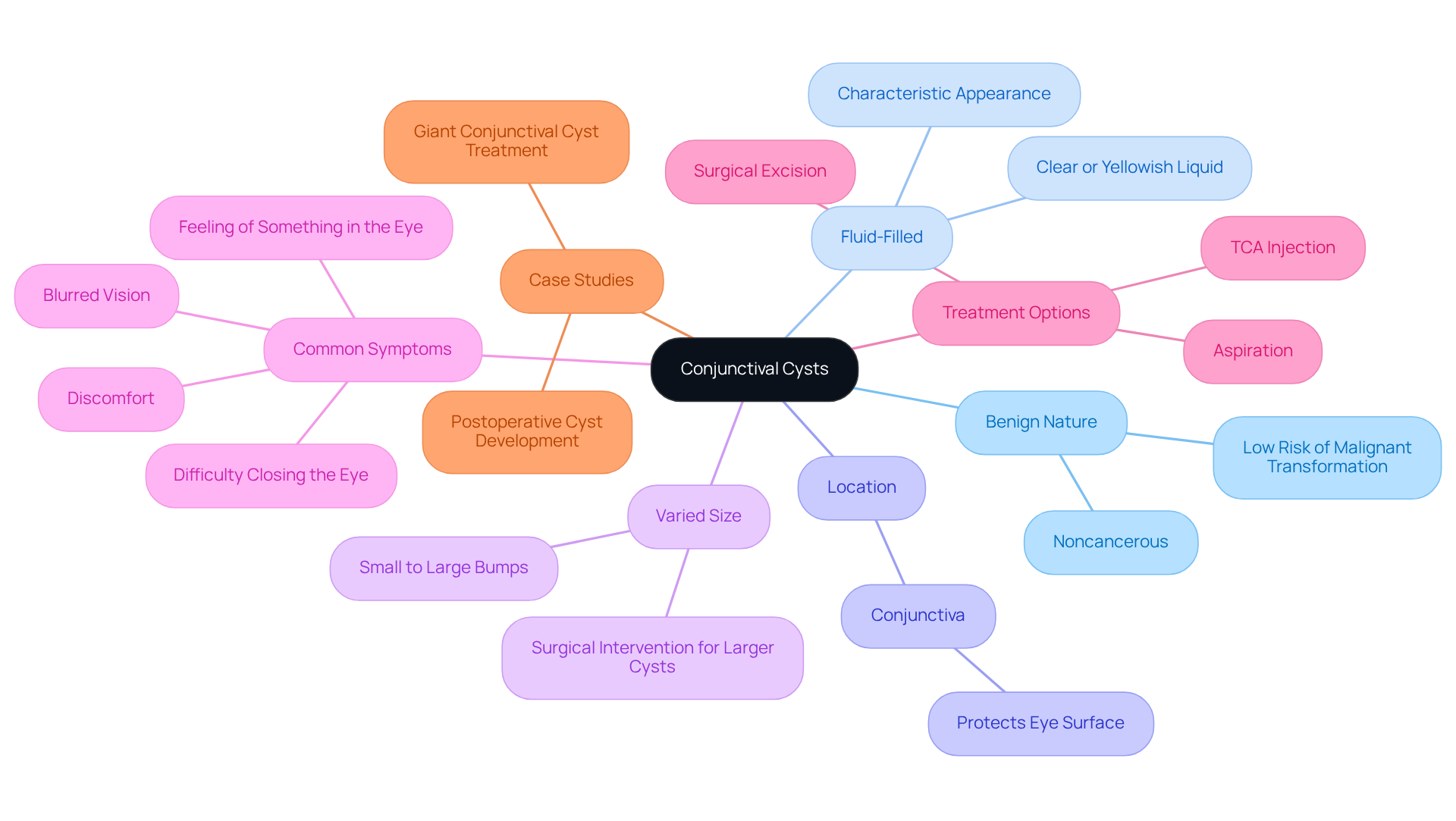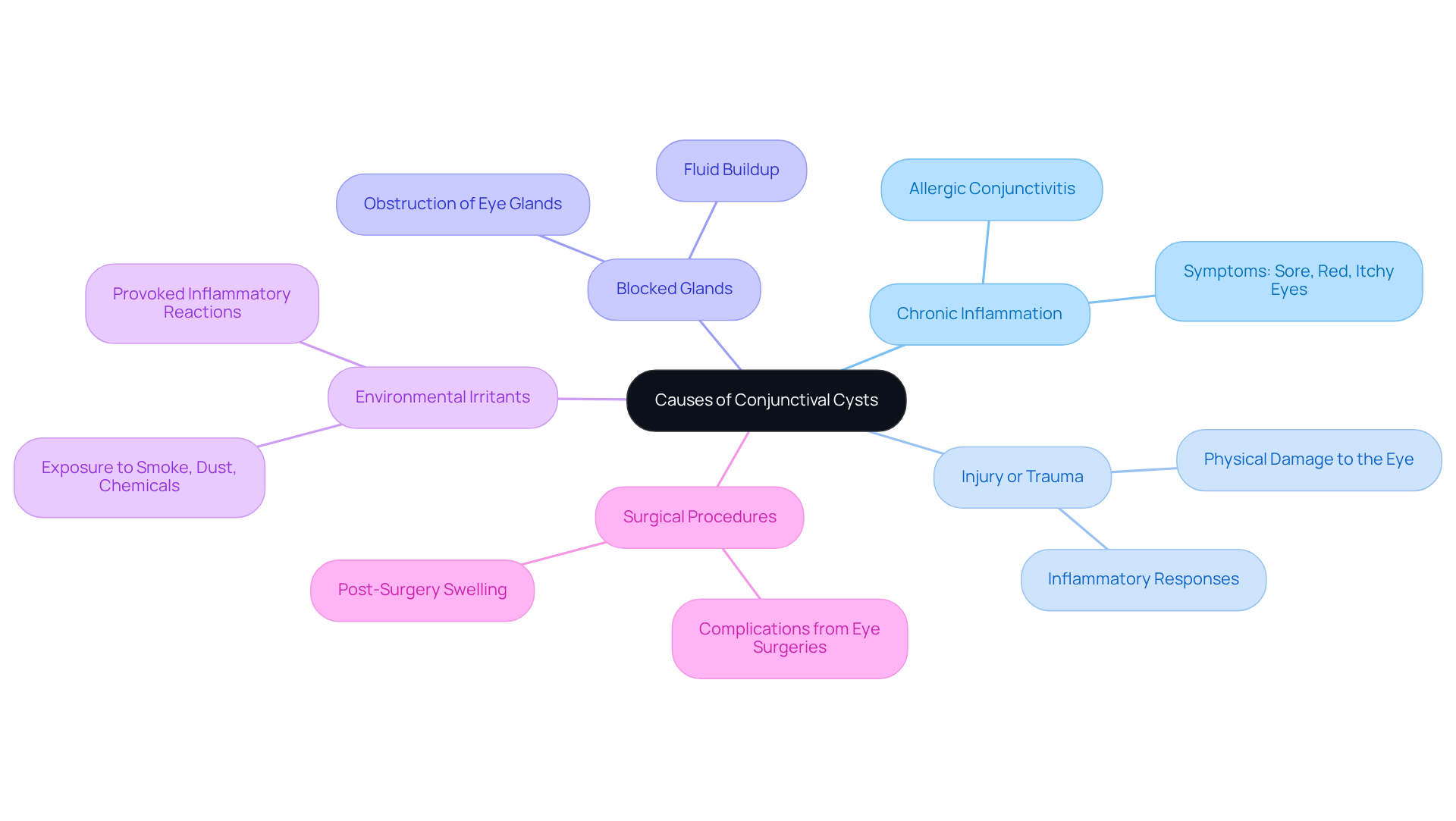Posted by: Northwest Eye in General on July 9, 2025
Overview
Conjunctival cysts are benign, fluid-filled sacs that can develop on the eye’s conjunctiva. These often appear as painless bumps, and while they may not always require treatment, it’s important to address any discomfort or visual disturbances they may cause. We understand that dealing with eye issues can be concerning, and we want to reassure you that you’re not alone in this.
In this article, we explore the causes, symptoms, and treatment options for conjunctival cysts. Monitoring these growths is crucial, and consulting with an ophthalmologist can provide you with the appropriate management, especially when symptoms arise. Remember, it’s common to feel uncertain about what to do next, but seeking professional guidance can help you find clarity and peace of mind.
We are here to help you through this process, ensuring you receive the care you deserve.
Introduction
Conjunctival cysts are often overlooked, yet they are benign growths that can appear on the eye’s surface, causing concern for many individuals. We understand that encountering such growths can be unsettling. Therefore, understanding their characteristics, causes, and symptoms is crucial for anyone seeking to maintain eye health.
What happens when these harmless sacs begin to interfere with daily life? It’s common to feel anxious about this, but there are effective ways to manage them.
This article delves into the essential aspects of conjunctival cysts, offering insights into their nature, potential triggers, and various treatment options available. We are here to help you through this process.
Define Conjunctival Cysts: Nature and Characteristics
A membrane growth is a harmless (noncancerous) formation that arises on the eye’s covering, the thin, clear layer encasing the white part of the eye and the inner eyelids. These formations are usually fluid-filled sacs, which can differ in size and may appear as small, clear, or yellowish bumps. Generally painless, a conjunctival cyst often goes unnoticed unless it grows large or becomes symptomatic. We understand that recognizing these growths can be concerning, so it’s important to understand their nature for timely medical intervention.
Key Characteristics:
- Benign Nature: Conjunctival cysts are noncancerous and usually harmless, with a low risk of malignant transformation.
- Fluid-Filled: These sacs contain a clear or yellowish liquid, contributing to their characteristic appearance.
- Location: They are found on the conjunctiva, which serves to protect the eye’s surface from environmental irritants.
- Varied Size: Conjunctival cysts can range from very small to larger, noticeable bumps, with some cases requiring surgical intervention if they cause discomfort or visual disturbances.
It’s common to feel uncertain about eye lesions, especially since they are more prevalent in individuals over 45 years old, although they can occur in younger patients as well. For example, a case study showcased a 51-year-old woman with , demonstrating that although these growths are harmless, they can cause considerable discomfort and necessitate treatment. In reality, conjunctival cysts account for approximately 80% of all fluid-filled lesions of the conjunctiva, highlighting their commonness.
Overall, while eye sacs are generally harmless, awareness of their traits and possible symptoms—such as discomfort, blurred vision, a sensation of something caught in the eye, and difficulty closing the eye—is crucial for recognizing when medical attention may be necessary. We encourage you to consult a Northwest Eye doctor for an accurate diagnosis and appropriate treatment, especially if you experience any concerning symptoms. Remember, we are here to help you through this process.

Identify Causes: Factors Leading to Conjunctival Cysts
Understanding the factors that can lead to conjunctival cysts can help you feel more in control of your eye health. We recognize that dealing with eye issues can be concerning, so let’s explore some common causes together:
- Chronic Inflammation: Conditions such as allergic conjunctivitis can lead to irritation and subsequent cyst formation. Persistent inflammation is a major factor, as it can interfere with normal conjunctival function and encourage the formation of sacs. Symptoms such as sore, red, and itchy eyes may be associated with .
- Injury or Trauma: Physical damage to the eye, whether from accidents or surgical interventions, can lead to the development of sacs. Eye injuries are a notable risk factor, as they can trigger inflammatory responses that may result in the development of a conjunctival cyst.
- Blocked Glands: Retention sacs happen when the channels of the eye’s glands become obstructed, leading to fluid buildup. This blockage can stem from various factors, including inflammation or trauma.
- Environmental Irritants: Exposure to irritants such as smoke, dust, or chemicals can worsen eye irritation, contributing to the formation of sacs. These irritants can provoke inflammatory reactions that heighten the chances of sac formation.
- Surgical Procedures: Cysts may develop as complications following eye surgeries, including cataract surgery or strabismus correction. Post-surgery swelling and alterations in eye tissue can result in a conjunctival cyst, which is a fluid-filled sac.
We understand that recognizing these reasons is essential for identifying risk factors and applying preventive strategies to reduce the chance of eye sacs. Remember, untreated symptoms can lead to serious health complications. If you are experiencing symptoms, we encourage you to reach out for a consultation now. We are here to help you through this process.

Recognize Symptoms: Signs of Conjunctival Cysts
While many may be asymptomatic, some can present noticeable signs that warrant attention. We understand that recognizing these symptoms is essential for timely intervention, as untreated issues can lead to serious health complications. Be Eye Wise and learn about routine eye care to better understand your eye health:
Common Symptoms:
- Visible Bump: A clear or yellowish bump on the conjunctiva, typically painless, is often the first sign.
- Discomfort: It’s common to feel as though something is stuck in your eye, which can be bothersome.
- Redness and Irritation: The surrounding areas may appear red or inflamed, especially if the sac is large or causing pressure.
- Excessive Tearing: Heightened tear production may occur as a reaction to irritation from the sac.
- Swelling: The eyelid may become enlarged if the sac exerts pressure on it.
If you experience any of these symptoms, especially if they worsen or lead to significant discomfort, we encourage you to consult an eye care professional. Timely identification and handling can help avert complications and enhance your outcomes, as most eye sacs are treatable with appropriate care.
Explore Treatment Options: Managing Conjunctival Cysts
Management of conjunctival cysts can be a source of concern, and it largely depends on their size, symptoms, and how they affect your quality of life. We understand that navigating these options can feel overwhelming, so here are to consider:
- Observation: If the cyst is small and doesn’t cause any symptoms, simply monitoring it might be all that’s needed.
- Warm Compresses: Applying warm compresses can ease discomfort and may even help the lump drain naturally.
- Lubricating Eye Drops: These drops can soothe irritation and dryness associated with growths, providing some relief.
- Aspiration: This minor procedure involves puncturing the sac to drain fluid, offering temporary relief from discomfort.
- Surgical Excision: If the sac is bothersome or keeps coming back, surgical removal may be necessary. This procedure is typically performed under local anesthesia and serves as a definitive solution.
- Laser Treatment: Argon laser photoablation is for removing cysts, especially effective for smaller ones.
Consulting with an ophthalmologist is crucial. They can help determine the most suitable treatment based on your unique situation. Remember, we are here to help you through this process, ensuring you feel supported every step of the way.
Conclusion
Understanding conjunctival cysts is essential for maintaining eye health. These benign growths, while generally harmless, can lead to discomfort and require appropriate management. We understand that recognizing their characteristics, causes, symptoms, and treatment options empowers you to take proactive steps in addressing any concerns that may arise.
Conjunctival cysts are fluid-filled sacs that can vary in size and may appear as painless bumps on the eye’s surface. Common causes include:
- Chronic inflammation
- Injury
- Environmental irritants
Symptoms may include:
- Visible bumps
- Discomfort
- Excessive tearing
Treatment options can range from simple observation and warm compresses to more invasive procedures like surgical excision or laser treatment, depending on the severity and impact on your quality of life.
Ultimately, staying informed about conjunctival cysts enhances your ability to seek timely medical attention and ensure effective management. If you experience any symptoms, please do not hesitate to consult an eye care professional to discuss your situation and explore suitable treatment pathways. Prioritizing your eye health is crucial, and understanding these common eye conditions is the first step toward maintaining clear and comfortable vision. We are here to help you through this process.
Frequently Asked Questions
What are conjunctival cysts?
Conjunctival cysts are harmless, noncancerous formations that appear on the eye’s covering, known as the conjunctiva. They are usually fluid-filled sacs that can vary in size and may appear as small, clear, or yellowish bumps.
Are conjunctival cysts painful?
Generally, conjunctival cysts are painless and often go unnoticed unless they grow large or become symptomatic.
What are the key characteristics of conjunctival cysts?
Key characteristics include their benign nature (noncancerous), fluid-filled composition, location on the conjunctiva, and varied size, which can range from very small to larger noticeable bumps.
Who is more likely to develop conjunctival cysts?
Conjunctival cysts are more prevalent in individuals over 45 years old, but they can also occur in younger patients.
What symptoms might indicate a need for medical attention regarding conjunctival cysts?
Symptoms that may indicate a need for medical attention include discomfort, blurred vision, a sensation of something caught in the eye, and difficulty closing the eye.
How common are conjunctival cysts?
Conjunctival cysts account for approximately 80% of all fluid-filled lesions of the conjunctiva, highlighting their commonness.
When should someone consult a doctor about conjunctival cysts?
It is advisable to consult a doctor if you experience any concerning symptoms related to conjunctival cysts for an accurate diagnosis and appropriate treatment.






